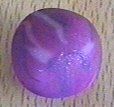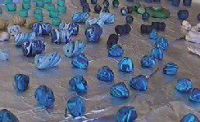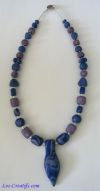Fimo modeling clay, polymer clay
Fimo modelling clay (or any other brand) is a baking clay ideal for shaping small objects and, if you're patient, for making beads and jewelry, as Magali does.
Fimo clay, or polymer clay, is ideal for making small assemblies to create gourmet miniatures, beads and jewelry, decorate small objects or make figurines. It lends itself well to the Millefiori technique, the creation of canes that can then be cut into strips and glued onto metal objects (cutlery, barrettes, brooches...). Polymer pastes can also be used to create highly detailed figurines.
Magali shares her secrets and tips for creating with Fimo, and her creations are presented in the amateur gallery"Les bijoux Fantaisie en Fimo".
" First of all, modelling clay should not be left in everyone's hands. Bear in mind that it is an unnatural product. Manufacturers therefore advise against its use by children under 8, because as soon as it is shaped, a film is deposited on the fingers, with the risk of young children rubbing their eyes or putting their fingers in their mouths. For them, it's better to model with salt dough or clay, natural materials that will be more pleasant for them.
the best-known is Fimo clay, which comes in two ranges: "soft", which is immediately malleable, and "classic", which needs to be worked well before use to restore its suppleness. Soft" has the disadvantage of crushing in certain applications, as in the Millefiori technique.
" First of all, modelling clay should not be left in everyone's hands. Bear in mind that it is an unnatural product. Manufacturers therefore advise against its use by children under 8, because as soon as it is shaped, a film is deposited on the fingers, with the risk of young children rubbing their eyes or putting their fingers in their mouths. For them, it's better to model with salt dough or clay, natural materials that will be more pleasant for them.
the best-known is Fimo clay, which comes in two ranges: "soft", which is immediately malleable, and "classic", which needs to be worked well before use to restore its suppleness. Soft" has the disadvantage of crushing in certain applications, as in the Millefiori technique.
Sculpey brand paste is very supple and comes in bright, even fluorescent colors, making it popular with teenagers. However, it leaves a slightly greasier film on the skin than Fimo and has a stronger fragrance, especially when baked. There are also Cernit, GemColor and Creall-Therm brands. But as it's probably not advisable to mix pastes from different brands, we generally stick to a single one, unless you want to try out your own mixes.
Let's talk about cooking...
Unlike salt dough, which takes hours to bake, or clay, which is baked at high temperatures, Fimo dough can be baked in 30 minutes at 130°c, or even less if the pieces to be baked are not very thick. Sculpey dough takes 15 minutes to bake in an oven at 130°c for 6mm thick dough. Strictly follow the manufacturer's instructions and, above all, never exceed the cooking times (the dough will then release noxious gases). Cook in a ventilated room, away from children, and never in the microwave. Please note: when the dough comes out of the oven, it doesn't yet have its final consistency; it needs to cool before it's really hard.
Don't let these recommendations frighten you, because bakeable modeling clay (Fimo or other) has many qualities to seduce us:
Concerning varnishing: use a specific varnish (Fimo varnish for Fimo clay, etc...) as there is a risk of chemical reaction and a classic varnish (or even the nail varnish you may be tempted to use) will irreparably soften the modeling.
- once baked, it's very hard: a pearl thrown at full force on the floor... bounces back happily without even getting damaged!
- it's water-resistant: it's even a good way to cool it quickly when it comes out of the oven,
- it can be varnished for even more shine
Concerning varnishing: use a specific varnish (Fimo varnish for Fimo clay, etc...) as there is a risk of chemical reaction and a classic varnish (or even the nail varnish you may be tempted to use) will irreparably soften the modeling.
Creating beads with Fimo is really easy - any shape is possible! The hole for each bead is made with a needle, thinner or finer depending on the diameter required for threading (on nylon thread or thicker thread such as cotton), taking care not to deform the bead.
These beads can then be used to make jewelry, from simple threading to more varied techniques such as macramé bracelets with Shamballa-style bead inclusions...
I wish you lots of fun with these manual activities... " Magali
I wish you lots of fun with these manual activities... " Magali
Also to be discovered on Les-Créatifs:
-
the
- Fimo marbling technique, the Millefiori technique,
- making salt dough, practical when you don't have any Fimo on hand and you really want to model! ...
- and a hundred other creative cards







